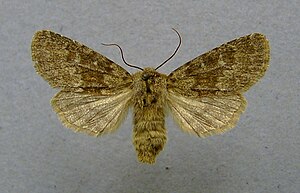Hogweed wire-haired owl
| Hogweed wire-haired owl | ||||||||||||
|---|---|---|---|---|---|---|---|---|---|---|---|---|

Hogweed wire-haired owl ( Dasypolia templi ) |
||||||||||||
| Systematics | ||||||||||||
|
||||||||||||
| Scientific name | ||||||||||||
| Dasypolia templi | ||||||||||||
| ( Thunberg , 1792) |
The hogweed wire-haired owl ( Dasypolia templi ) or temple owl is a butterfly ( moth ) from the owl butterfly family (Noctuidae).
features
butterfly
The wingspan is about 42 to 56 millimeters. The color of the forewings is quite variable and varies from ocher yellow to green-gray or dark brown-gray, sometimes with indistinct blemishes marked by light dots or lightly filled inside. The transverse lines are toothed dark and often washed out. The hind wings vary in the color of the forewings, but they are always a bit lighter and have two weak transverse lines. The following forms are described:
- f. templi nominate form with ocher yellow fore wings
- f. variegata with blue-gray to green-gray forewings
- f. alpina form of the Alps, which is a little darker and more colorful
The proboscis of the moths is stunted.
Egg, caterpillar and pupa
The egg is hemispherical, strongly flattened at the base and strongly ribbed. It is yellowish at first, later strong red with a dark spot on the upper pole and a ring below it. The caterpillars are yellowish to white. The back is tinted pale pink and has large, black pointy warts. The head is dark brown. The doll is red-brown in color, slender and has two thorns on the cremaster .
distribution and habitat
The species is locally distributed in Europe, mainly in the boreal- alpine region, but only common in a few places. In the Alps it occurs from the valley up to an altitude of over 2,000 meters. The hogweed wire-haired owl loves moisture and prefers shady valleys, forest edges and wet meadows.
Way of life
The species forms one generation per year. Since the moths hibernate, they appear early in the year on the first warmer evenings and fly into May. In the Alps, they can be seen while the snow is melting. The moths are nocturnal and like to fly to artificial light sources . The eggs are laid on the flowers of the forage plant. The caterpillars live in June and July. They feed on meadow hogweed ( Heracleum sphondylium ), first on the flowers, then on the fresh stems and finally on the roots. Pupation takes place in the rhizome. The new generation of butterflies will appear from the end of July.
Danger
In Germany the species occurs only in a few federal states and is on the Red List of Endangered Species in Category 2 (highly endangered).
swell
literature
- Walter Forster , Theodor A. Wohlfahrt : The butterflies of Central Europe. Volume 4: Owls. (Noctuidae). Franckh'sche Verlagshandlung, Stuttgart 1971, ISBN 3-440-03752-5 .
- Manfred Koch : We determine butterflies. Volume 3: Owls. 2nd, expanded edition. Neumann, Leipzig / Radebeul 1972, DNB 760072930 .
Individual evidence
- ↑ Manfred Koch: We identify butterflies. Volume 3: Owls. 2nd, expanded edition. Neumann, Leipzig / Radebeul 1972, DNB 760072930 .
- ↑ a b c d Walter Forster, Theodor A. Wohlfahrt: The butterflies of Central Europe. Volume 4: Owls. (Noctuidae). Franckh'sche Verlagshandlung, Stuttgart 1971, ISBN 3-440-03752-5 .
Web links
- www.lepiforum.de Taxonomy and photos
- www.nic.funet.fi dissemination
- www.schmetterlinge-deutschlands.de Occurrence and endangerment in Germany
- Dasypolia templi at Fauna Europaea